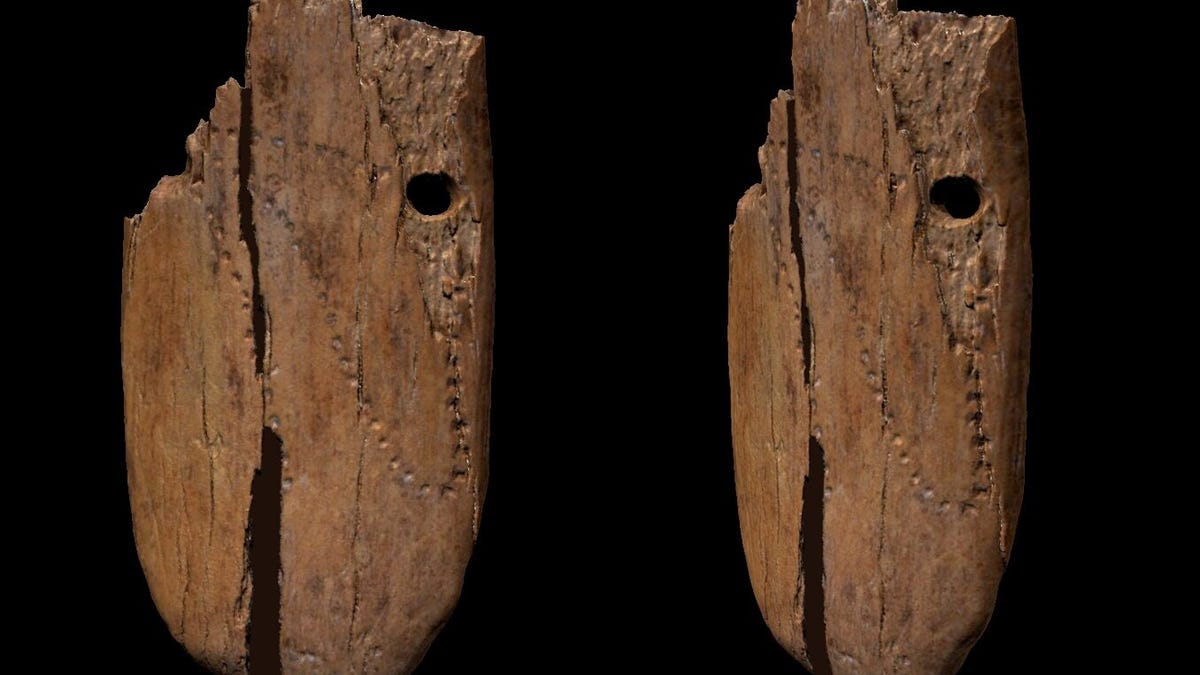Pendant from 41,500 years ago may have uncovered a 'step in evolution'
"When I saw it, I was shocked."

The pendant, seen here in slightly different views, would've been about 4.5 centimeters (1.8 inches) long and 1.5 centimeters (just over half an inch) wide, with a thickness between 0.36 and 0.39 centimeter (1.4 and 1.5 inches).
In 2010, scientists unearthed an ivory pendant from an abandoned Polish cave. Punctured with patterns reminiscent of moon cycles and mathematics, the artifact's origins eluded archaeologists -- until now. An international team of researchers just declared the relic to be 41,500 years old.
That makes it the earliest piece of ornate jewelry ever found in Eurasia, and a wonderful reminder that art is timeless. Images and details of the discovery were published Thursday in the journal Scientific Reports.
But beyond its aesthetic value, this ancient pendant also marks the first proof of post-Neanderthal civilization in the Polish region, enriching our textbooks with new data on the movement of early human populations.
"It was not expected to have any evidence of early Homo sapiens in this cave, because it was sort of seen as a Neanderthal cave," said Sahra Talamo, lead author of the study. "This sort of shows the next step in evolution."
The Polish cave where the pendant was excavated.
The pendant's modern story began 11 years ago, when researchers excavated two fragments of it in Poland's Stajnia Cave. Each piece is made of mammoth bone and has unique looping designs etched with a sequence of dots. There are two holes on the adornment, which presumably were used to attach a string of sorts to make a necklace.
"When I saw it, I was shocked," Talamo said of her first encounter with the item.
The confusion came from its location in a stratigraphic layer of the cave attributed to Neanderthals. Tools, and even teeth, of the human ancestors had already been discovered there. But according to Talamo, it was peculiar to connect the jewelry to the early humans, because of the dotted decorations. Such artwork is typical of Homo sapiens, who lived after the Neanderthal era, and are thought to have engaged in more-complicated creative endeavors.
Neanderthals had their own jewelry, but it wasn't nearly as elaborate as what's on the pendant. Armed with a ton of questions, Talamo decided to investigate.
Talamo is an expert in the field of radiocarbon dating, a method that uses an isotope of carbon to determine the age of organic material. Lo and behold, the pendant didn't originate with the Neanderthals. It likely just migrated to a lower layer of the cave even though it was made by later generations from the Early Upper Paleolithic era.
Given its rarity, she also suggests these relics were probably not commonplace items for the Homo sapiens. Perhaps it could've been a status symbol of sorts?
Interestingly, the pendant's remains were found alongside an ancient awl, or small pointed tool used for piercing holes. Coincidence? Well, probably. The team realized the awl dates back 500 years prior to the pendant's creation, and either way, was likely too "soft" to make the dotted markings in bone. That finding is also a result of Talamo's radiocarbon dating technique.
Unlocking the past while preserving history
Typically, radiocarbon dating is seen as invasive because it requires breaking off a physical piece of the object being studied. As Talamo puts it, it's a "destroying method."
But for the purpose of this study, she invented a new way to radiocarbon-date. It requires only a tiny piece of the artifact to arrive at an accurate result while preserving nearly all the delicate art, teeth or tools being examined.
"I tried to develop this method because I want to destroy as little as possible," Talamo said, but "start to combine this puzzle of human evolution with a real piece of the puzzle."
Going forward, Talamo's novel technique could be employed for other fossils or artifacts. She hopes to apply it to ancient jewelry found in France and Germany, for example, but thinks it could help decode any valuable objects worth studying.
Sahra Talamo (left) as she hands her 3D representation of the ancient pendant and accompanying awl back to Polish researchers.
A future queue of such objects could include similar decorated ornaments, then move to figurines and weapons. The possibilities are endless, which Talamo hopes will prove radiocarbon dating can be done in a careful way by any team across the globe -- an important consideration, she says, because archaeology requires a grand perspective.
"You have to have a big team with different minds, different opinions, different disciplines that work together for the same goal," she stressed. "This will make it stronger -- the evidence that we're going to bring to the world."

